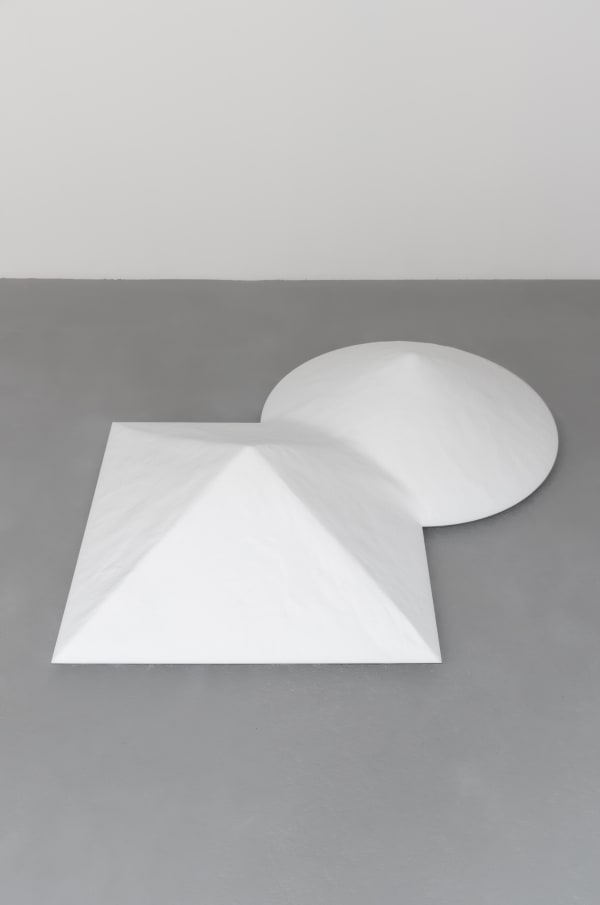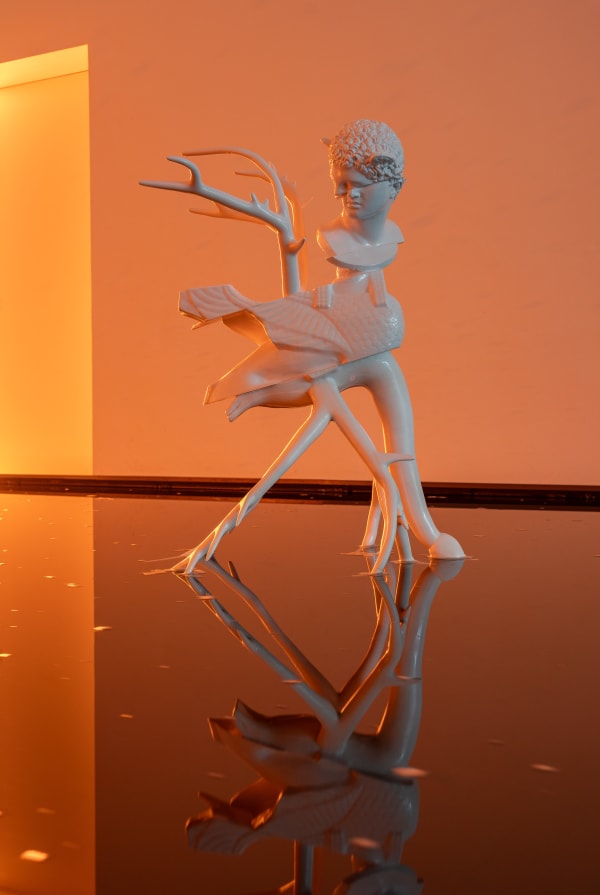
Troika is a contemporary art group founded in 2003 by Eva Rucki (*1976, Germany), Conny Freyer (*1976, Germany), and Sebastien Noel (*1977, France). The artists live and work in London, UK.
The collective's paintings, sculptures, films, and large-scale installations contemplate on the intersections between analog and digital realities. At the center of their interest are humanity's experiences and knowledge gained through technology and how these transform our understanding and relationships to nature, society, and reality. Troika's collaborative approach is usually based on in-depth scientific research in the fields of natural philosophy and the history of technology. Their work incorporates complex questions about artificial intelligence, algorithmic data, alternative forms of life, and virtual and physical representation systems.
Detailed photos and further information on the individual works can be opened by clicking on the respective images.
All Photos: Dirk Tacke and Marjorie Brunet Plaza | unless otherwise stated
Troika (2025) | Courtesy of Troika and AMEX, photo: Joe Hart

"Since we started working together we have been observing and reflecting on how technological advancement is influencing our life, people's lives. This is broad but if one starts to look closer most of our everyday actions, interactions or decisions are in one way or other governed, altered, streamlined, aided, assisted by some form of technology."
– Troika
Installation view No Sound of Water, Arte Abierto, Mexico City (2021) | Photo: Studio Troika

Troika recently opened with deception island the new gallery spaces of max goelitz in Munich. Previously, they exhibited in 2025 at the Schirn Kunsthalle in Frankfurt, at the Künstlerhaus in Dortmund, and the Max Ernst Museum in Brühl. In addition to the solo exhibition anima atman at max goelitz in Berlin, Troika's most extensive solo exhibition to date Pink Noise was opened in 2024 at the Langen Foundation in Neuss. Further solo exhibitions have been presented at MAK in Vienna (2024), Espacio Arte Abierto in Mexico City (2021), Barbican Gallery in London (2019), NC-arte in Bogotá (2015) und Daelim Museum in Seoul (2014). Troika's works were also part of the group exhibition Poetics of Encryption at KW Institute for Contemporary Art in Berlin.
Installation view Pink Noise, Langen Foundation Neuss (2024)

Out of Place, Out of Time (2025) brings together a series of speculative landscapes in which Troika stages unlikely encounters between geological epochs, digital processes, and speculative memory. An extinct species of Key Largo cactus appears to grow in Arctic ice or take root in tropical swamplands. The imagery evokes projections of a mechanical subconscious, fed by the collective visual memory of the Earth. These images were created using text-to-image algorithms that generate visuals from short language inputs in fractions of a second. Formally, Troika transfers these fleeting visions into a medium of physical permanence: platinum printing. This 19th-century photographic process uses platinum and palladium salts—materials employed in the early days of photography as well as in today's semiconductor technology. The choice of this durable medium gives the image a material presence that extends far beyond the ephemeral input of digital algorithms. A paradoxical alliance that renegotiates the relationship between time, memory, and image production.

Troika deliberately draws on the tradition of early landscape photography, such as Timothy O'Sullivan's 19th-century expeditions. But while months of travel were necessary back then, today a short command to a neural network is enough to discover new terrains. Troika's imaginary biotopes negotiate not only geographical disorientation, but also a shift in our understanding of reality: What does “nature” mean when it is not only represented but also reconstructed through algorithmic processes? Which images and narratives emerge and which are lost in the process? Out of Place, Out of Time thus creates a topography of uncertainty. The series reflects not only on this new form of digital access to nature, but also on its ecological costs: computing power, energy consumption, and rare minerals lie behind the apparent immateriality of digital image production.
Troika, Out of Place Out of Time (Lostmans River), 2025

The sculptures in the Ultraflora series (2025) appear as intricate, metallic structures whose surfaces seem to have grown organically and yet been artificially modeled. The works combine echoes of plant tissue, root systems, and mechanical processes. Volumetric scans of so-called pioneer plants—such as the Tree Aeonium, known for its ability to survive in extreme climates–are mapped onto a virtual spatial grid, reshaped, and then re-materialized with the help of a robotic arm, layering molten metal filament, allowing it to grow in successive strata into its final form. These sculptures embody a transition zone between the organic and the technological. The resulting “Grenzgänger” or border-crossers belong to Troika's speculative Field Guide to Virtual Botany. These are species that exist in liminal spaces, defy traditional classifications, and actively change their environment. They grow where opposites meet, at the edges of land and sea, between life and death, between reality and fiction.

As ecological wanderers, symbolic threshold beings, and metaphorical markers, these species take on a new form. What was once vegetative now emerges as a techno-organic relic – prototypes of post-biological growth. Each sculpture stands on a roughly cut pedestal of elm wood, its annual rings, saw marks, and remnants of bark echoing the lines and structures of the sculptures above, grounding the work in the symbolism of the elm long believed to bridge realms and connect worlds. In this field of tension between formal functionality and organic metaphor, Ultraflora moves between archaic memory and futuristic speculation.
Installation view deception island, max goelitz, Munich (2025)

In Programming Harmony Touching Clear Sky, Troika depicts vast landscapes that initially appear from a distance to be monochrome representations of nature. Green areas seem to suggest a desert, a distant hilly landscape, or the horizon. But as you get closer, the composition dissolves into a uniform grid: hand-painted squares, carefully placed, sixteen shades of color between light and dark, reminiscent of the logic of digital pixels. The image surface acts like a filter that both reveals and conceals the scene. While a landscape appears from a distance, on closer inspection the structure of the medium itself comes to the fore. The series is based on images from surveillance cameras and satellites, which are present even in the most remote regions of the earth. Images from the Mojave Desert or other isolated places become visible—mediated by technical systems that break down the landscape into data before translating it into color.
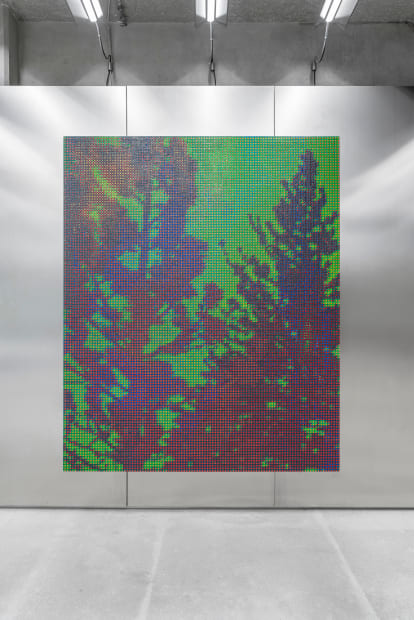

Troika's work series Forest Filled with Pines and Electronics (2023) is inspired by the "Internet of Trees" and depicts forest fires in California that were recorded by a network of CCTV cameras attached to trees as early warning systems. These filmed their own demise: how first the forest and eventually the cameras themselves were engulfed in flames. The colors of the base coat seem to flow into each other and the pixel structure is broken by irregularities. In some works of the series, the numbers that define the shade of paint in the process of creation remain visible, as if the paint had been dripped down by heat and only the structure of the image remained. Thus, Forests Filled with Pines and Electronics shows the physical feedback of the fires on the captured image, in that the canvas itself seems to melt into its component parts.

Troika thus reveals a dual experience: while technology allows us access to places that are physically inaccessible to us, it also increases our distance from nature when it becomes visible only through grids, filters, and digital systems. By transferring the principle of digital image production to painting, the artists focus on the conditions of seeing itself and the question of how we perceive our environment today. Programming Harmony Touching Clear Sky, Forest Filled with Pines and Electronics und Irma Watched Over by Machines makes it clear that our view of the world is increasingly mediated by machines and that our perception of nature is already shaped by this perspective.
Studio view, London | Photo: Studio Troika

- Troika
Studio view, London | Photo: Studio Troika

The work Irma Watched over by Machines (2020) is part of Troika's series of works, in which video recordings of windswept palm trees during Hurricane Katrina and Irma were translated onto canvas. On closer inspection, the painted surface is finely pixelated, the specific colors based on a raster of the digital RGB color space. The dominant green shade of Irma Watched Over by Machines is created by breaking the image down into color mosaics correspondent to the digital image recordings, in which there are twice as many green as blue or red pixels in the image. The effect of the digital image counteracting with the increased sensitivity of the human eye to green hues, is carried over into the painting.

Troika replicates the technical perspective of the camera and transfers its logic manually onto the screen. The discrepancy between the objectification of the destructive event through the neutral, technical recording and the actual destructive content of the image, a natural disaster, potentially arousing emotional associations, becomes clear. Troika's translation on canvas becomes a mechanical act in which the exact color values are predetermined and the color grid is applied by syringe. The painting style is characterized by manual replication and repetition, requiring mechanical precision. The artists investigate how digital information merges into physical reality and how both worlds interact with and influence one another.
Installation view Pink Noise, Langen Foundation Neuss (2024)
Installation view in a forest of red, green and blue, max goelitz, Munich (2023)

In Troika's installation Anima Atman (2024), thistles emerge from a desolate landscape of silicon rocks, moving in slow motion as though infused with a spirit or invisible life force. Through this surreal depiction, Troika highlights the intelligence of plants, contrasting it with human cognition in contemporary philosophical discourse. Unlike the human brain's neuronal network, plants lack such a structure, yet possess the ability to swiftly adapt and anticipate external conditions, altering their growth direction in a beneficial manner. Anima Atman visually portrays this adaptability by illustrating the plants' movement, thereby challenging the notion, influenced by Western philosophy, that cognition is confined to the brain. The title Anima Atman (Anima (Latin) means breath or soul; Ātman (Sanskrit, term from Indian philosophy) encapsulates a life force and intelligence inherent in various organisms.

"With Anima Atman, our familiar world turns unfamiliar, strange and alien, placing us at the threshold of uncertainty, and in a state that no longer is what it was, and not yet is what it will be."
– Troika

Thistles, as resilient organisms, thrive in harsh conditions and reclaim abandoned landscapes, once inhabited and later neglected due to human activity or adverse climate. In Anima Atman, the wasteland is composed of silicon, extracted from the earth for computer chip production. This installation presents a futuristic vision wherein thistles, utilizing their intelligent abilities, endure amid the remnants of raw material extraction structures.
Installation view Buenavista, Schirn Kunsthalle Frankfurt (2025) | Photo: Roy Bon

The video work Buenavista (2025) reveals the imaginary inner workings of a machine. On the screen, an emergent life form roams fragmented digital landscapes, constantly searching for an ecological niche. Between chaotic simulations and fleeting topographies, its longing for the “beautiful view” appears like a mirror of our own desires and projections. This creates a state of limbo between technical imagination and human desire, in which the boundaries between nature, machine, and imagination dissolve.
Installation view Buenavista, Schirn Kunsthalle Frankfurt (2025) | Photo: Roy Bon
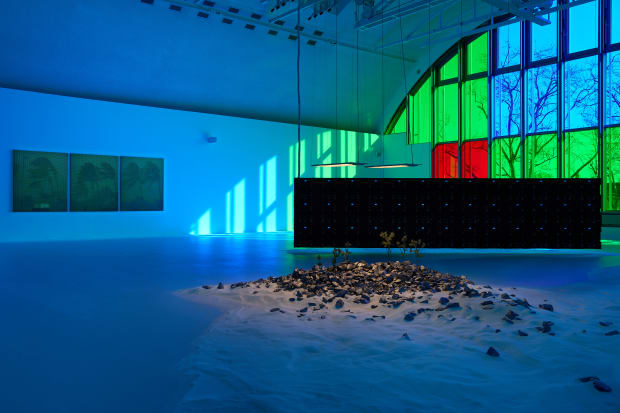
– Delia Hannah (curator)
Installation view Buenavista, Schirn Kunsthalle Frankfurt (2025) | Photo: Roy Bon

The work series Obsolete Landscapes (2024) shows fragments of desktop backgrounds printed on aluminum that Apple Inc. has been using for its operating systems since 2014, with the tech company drawing on impressive landscape images of mountain ranges, deserts and islands in California. Beginning with Yosemite (10.10.5) and El Capitan (10.11.6), the naming has expanded from the titles of individual peaks to entire mountain ranges such as Sierra (10.12.6) and High Sierra (10.13.6). The Mojave Desert (10.14.6) followed, as did Santa Catalina Island (10.15.7). Troika deliberately removes the iconic images from these backgrounds, leaving only the sections depicting the sky. The collective thus breaks with the aestheticized depictions of landscapes that show a view of supposedly untouched nature, which runs counter to the extractivism that is practiced to supply computer-based systems.

Obsolete Landscapes explores the relationship between technological advancement and the degradation of these landscapes - both in terms of the extraction of resources for the manufacture of products and the fact that with each new operating system, the previously selected landscapes become obsolete as a result of the update. Nature is reduced to a digital facsimile that symbolizes the human relationship to the environment as an interchangeable resource. The sky, untouched by capitalist appropriation, serves as a reminder of the interconnectedness of these places through the atmosphere, which envelops the entire planet in perpetual motion.

"We are interested in the shifting boundaries between nature and artifice, the real and the romanticised, the living and non-living, us and the other."
- Troika
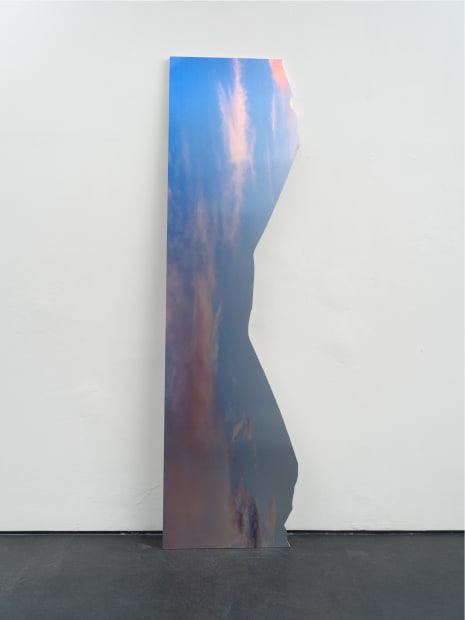
Installation view Drei Sekunden, Künstlerhaus Dortmund (2025) | Photo: Jens Sundheim

The multimedia work cycle Untertage reflects constant exploration of salt crystals as a driving force in humanity's evolutionary history. Through a series of works, the collective bridges millions of years in which salt has become a tool for control, domestication of nature, and alteration of our environment, as well as contributing to today's technological advancements. The title Untertage includes a series of works related to this debate, in which Troika attributes an independent effective power to salt and examines it as a formative actor of civilizational developments.
Installation view No Sound of Water, Arte Abierto, Mexico City (2021) | Photo: Studio Troika

– Seisma Magazine
Studio view, London | Photo: Studio Troika

Evolutionary Composite (2023) is part of a series of works in which Troika focuses on salt crystals as the driving force behind certain inventions and technologies, without which human civilization would not have developed in the way we know it. In the wall works, the collective juxtaposes two objects vital for human civilization: The oldest tool of mankind – a flint hand axe and a silicon wafer – are both used in the manufacturing of computers. Salt also plays an important role in the production of both, which has been refined as a material over the course of 3.3 million years. In light of this, it seems that salt, unto itself and by its own power, has continuously driven human progress. With Evolutionary Composite, Troika builds a bridge between the millions of years in which salt has been utilized as a tool for controlling and domesticating nature as well as changing our environment, and salt as a contributing factor to today's technological progress. At the same time, the works question the constant urge for growth, the status quo of modern life.

The sculpture Pile of Salt (2023) is composed of salt crystals that form an interconnected pyramid and cone. Although they share a common sculptural body of salt, they seem like two entities, each with its own starting point and acting separately. However, a metal plate forms the common layout onto which the fine crystalline salt is poured and, following the laws of gravity and self-assembly, forms their shape. The geometric contour of Pile of Salt defines the shape from which the sculpture grows.

Terminal Beach is an animated film depicting a futuristic end-time scenario in which an ape-like creature fells the supposedly last tree on Earth. With the help of motion capture, the movements of a person swinging an axe were recorded and transferred to a production robot arm with long dark hair. As a result, the robot generates an animalistic or humanoid appearance, conveying a strangely enraptured feeling. In this scenery, the robot ends what humanity began a long time ago – the progressive destruction of our planet. The title Terminal Beach is a reference to J.G. Ballard's collection of science fiction short stories, which focuses on the bitter paradox that the extraordinary creative power of the human imagination is surpassed only by its ruthless destructive instinct.
Installation view No Sound of Water, Arte Abierto, Mexico City (2021) | Photo: Studio Troika

In the series of sculptures Compression Loss and I woke up to find myself scattered across continents (2023) Troika draw from their collection of digitised sculptures and musea objects gathered from various online libraries. Reminiscent of porcelain, the works initially appear to be cast from one mold, while closer inspection reveals the layering of 3D printing. The digital twins of ancient, classical and contemporary objects are manipulated in a chain of 3D programs by digitally slicing them into clusters of equal thickness. These clusters are then brought back into the physical world as 3D prints, that are intermixed and reordered to create new configurations of the original objects.


The outcome collides traditional depictions and classifications of different epochs, cultural artefacts, belief systems and historical geographies, reinforced by their method of production which uses distributed manufacturing - 3D printing production facilities that are scattered across the globe - to recombine digital fragments of information, drawn across multiple periods, places, collections and contexts.
I woke up to find myself scattered across continents | Photo: Studio Troika

"Troika's work sits at the intersection of virtual and material worlds, and the creative use of emerging tools. The group explores the porous boundary between nature and technology today — showcasing how digital systems represent and construct our environment. At a time of climate crisis, and social instability attending digital change, their work underlines how a collision between machine and human imagination ushers in a new world."
– Dehlia Hannah & Nadim Samman, curators of the solo show Pink Noise, Langen Foundation
Installation view Poetics of Encryption, KW - Institute for Contemporary Art, Berlin (2024) | Photo: Studio Troika

In a Forest of Red, Green and Blue (Crisper) is composed of various depictions of birds: the Egyptian divine representation of the Horus falcon, a Ba statue, a half-human, half-bird-like figure often found on ancient Egyptian tombs, and an ancient representation of the Sphinx. Troika's creature Crisper is a composite of hybrid mythological beings, all with a close connection to the afterlife.
Installation view Pink Noise, Langen Foundation Neuss (2024)

Reality is Not Always Probable (2021) is a series of wall object with a lopsided wave-shaped pattern, a result of thousands of dice stacked upon and beside one another. Based on Troika's interest in the relationship between chance and control, the work represents the materialization of a computer simulation. The algorithm, which is based on the model of the cellular automaton, generates random systems, the starting point of which is determined by Troika. The order of dice in each row determines that of the next, creating complex sequences that are based on the binary principle of color and non-color.




Reality is Not Always Probable refer to the historical use of dice as a means of determining fate, chance and luck. The roll of the dice is based in the laws of probability to which the process of the algorithm runs contrary. It is autonomous and can exist independently to everyday life, while reality itself is increasingly influenced by computer-based systems. The work clarifies Troika's investigations into showing how new technologies permeate physical reality and individual perception.

– Troika
Studio view, London | Photo: Studio Troika

For the latest works in the series Troika developed a more complex algorithm than before, inspired by John Horton Conway's "Game of Life." In 1970, the mathematician developed a simple set of rules - an algorithm - applied to a simple grid of game pieces that could be used to explain complicated procedures. His algorithm was then used to model population growth, musical compositions, artificial life forms and even evolution. His simple "game" has influenced biologists, scientists and philosophers. Troika take this up to form different patterns using the algorithm, where these are not predictable, but can arrange themselves in each new process. In this work, Troika begins with a random row of colored and white cubes in the top row. Each subsequent row of cubes and color choice is then determined by the row above. Unlike early works in the series, the algorithm is no longer binary and defined to take into account the color of the cubes, from which the organic, growth-like patterns then emerge.

Installation View, Cartography of Control, Kohn Gallery, Los Angeles (2015) | Photo: Studio Troika

Die Quadratur des Kreises (2023) is part of an ongoing series of works in which Troika explores the multiple ways of perceiving and understanding the world. The sculptures are works with multiple facets, representing different geometric shapes in one. Inspired by Edwin Abbott's satirical novel "Flatland", in which the inhabitants of a two-dimensional world cannot recognize a three-dimensional object, these works are a mutation of different shapes perceived depending on the position of the viewer.
Installation view Die Quadratur des Kreises, R+V Wiesbaden (2023) | Photo: Anton Sahler




"We are interested in the idea how and if a single entity, view, discipline can attain a full image of reality."
– Troika
Installation view Die Quadratur des Kreises, R+V Wiesbaden (2023) | Photo: Anton Sahler
Installation view The Shape of a Circle in the Mind of a Square, Zealand Academy, Køge, Denmark (2020) | Photo: Studio Troika

The series Borrowed Light is a further development of the installation of the same name, exhibited at the Barbican, London in 2019 and in which a slowly moving film strip mirrored a steady sunrise and sunset. In both works, the layering of colored slide film strips creates a flow of intense color fields, comparable to abstract photography. The work is reminiscent of a sunrise or sunset, with the entire color spectrum representing this natural phenomenon. Rather than creating a recorded reality, Borrowed Light blurs the boundaries between experience and physical spheres, natural and man-made spaces.

The sunset is one of the most frequently recorded and reproduced photographic motifs, revealing the attempt to digitally capture a profoundly ephemeral event. Troika combines analogue and digital techniques in their production processes, in order to work with intangible and ephemeral media such as light to shape their reception as something malleable rather than absolute. The artists expand the two-dimensional image onto a three-dimensional object and explore how technology is changing the human relationship to reality and how the digital world is increasingly extending into the physical world.
Installation view Maybe we should stop thinking that everything always starts from the beginning, We The Curious, Bristol (2021) | Photo: Studio Troika

The work series Unstable Constructs is composed of acrylic glass and color fields on photographic slide film, their color spectrum is shifting in relation to the viewer’s perspective. The form refers to columns as supporting architectural elements, whose surfaces begin to shift through changes in position and develop a flowing color spectrum. In addition to their examination of perception, representation and formal reduction, Troika's works are also characterized by an immanent second level of meaning, in which critical attitudes towards processes of digitalization and associated social developments are revealed.
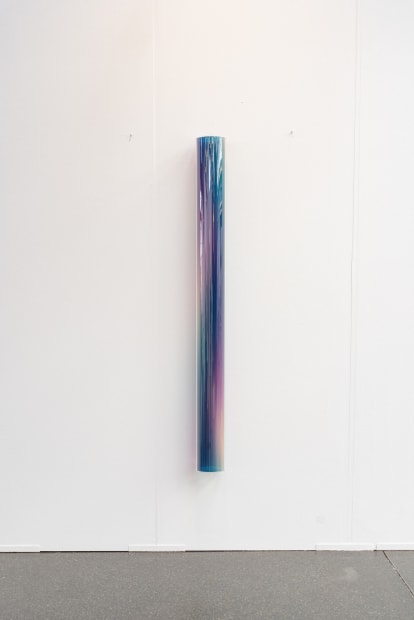
In Unstable Constructs, analog and digital techniques are combined. By integrating the computer-based RGB color space into the development of analogue slide film, the digital and physical worlds overlap. Troika question habits of reception and demand a state of active perception in real space.
Installation View Borrowed Light (2018), Barbican Center, London (2018-2019) | Photo: Studio Troika

Troika's Light Drawings, including Path of Least Resistance (2014) are created by electrical discharges burnt into the paper, leaving uncontrolled patterns in organic, branching forms. These traces evoke associations with rivers, blood vessels and plant roots – forms whose formations all go back to the same genetic law. The creation process of Path of Least Resistance is beyond any control and is guided solely by the resistance of the material and the force acting upon it. The current follows the trail of least resistance to close its circle.

Troika sets the starting point here – as in many of their works – and develops an aesthetic of unpredictability according to the principle of chance. At the same time, the Light Drawings capture the design of light and electricity, invisible per their nature, making their traces comprehensible and visible. Troika often resorts to scientific systems, whereby the repetition of under-energization is utilized here as a seemingly systematic cornerstone, permeating physical reality and its individual perception by coincidence.

Studio view, London | Photo: Studio Troika

Troika's cross-media works are part of the collections of the Center Pompidou, Paris; M+, Hong Kong; the Victoria & Albert Museum, London; the Art Institute of Chicago; the Museum of Modern Art, New York; Jumex Collection, Mexico City; and the Eretz Israel Museum, Tel Aviv. Troika realized three site-specific installations for the British Pavilion at World Exhibition 2010 Shanghai.
Installation view Poetics of Encryption, KW - Institute for Contemporary Art, Berlin (2024) | Photo: Studio Troika














